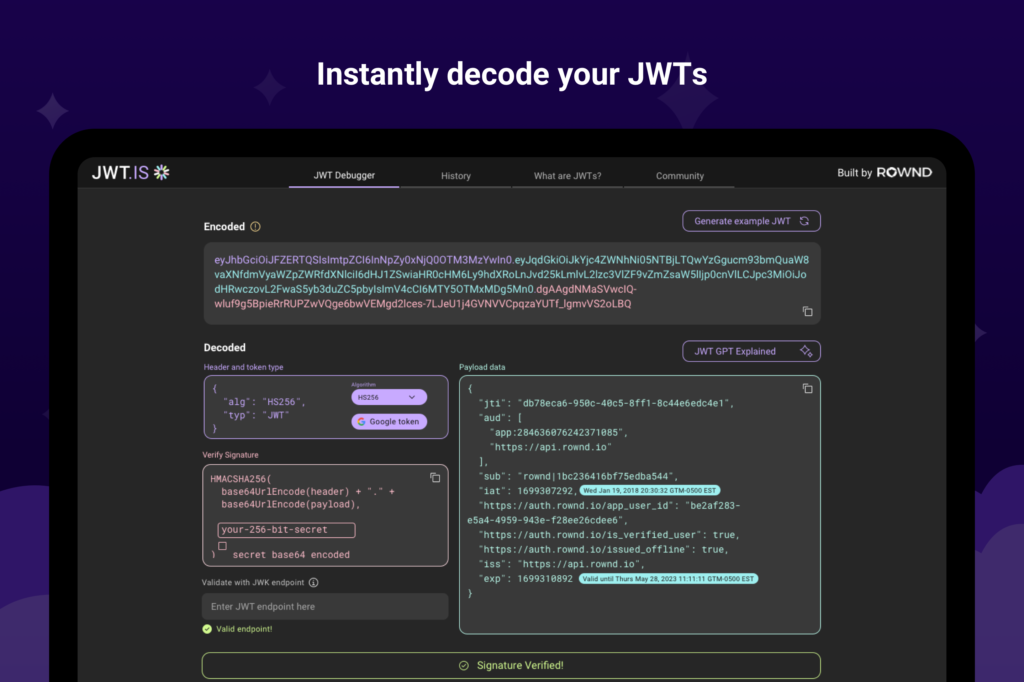
In the dynamic realm of web development and security, JSON Web Tokens (JWTs) have emerged as a cornerstone for secure communication and authentication. In this post, we dive into the world of JWTs, explore their significance, and introduce you to our latest JWT debugging tool, JWT.is, designed to simplify the debugging process.
Understanding JWTs: What Are They and Why Use Them?
What is a JWT?
JWT, or JSON Web Token, is a compact, URL-safe means of representing claims between two parties. These claims are often used to ensure the integrity and authenticity of transmitted data.
Why Use JWTs?
- Stateless Authentication: JWTs are widely used for authentication as they enable stateless and scalable user verification.
- Token-Based Authorization: They facilitate secure information exchange and authorization by cryptographically signing claims.
- Interoperability: JWTs work seamlessly across different platforms and programming languages.
- Compact and Self-Contained: JWTs are compact, making them efficient for transmission, and they contain all the necessary information for verification.
A Brief History of JWTs:
JWTs, standardized in RFC 7519, have a fascinating history rooted in web development and security protocols. Introduced in 2010, JWTs gained rapid adoption due to their simplicity and versatility. They are widely utilized in various contexts, from securing API endpoints to managing user sessions in web applications.
Introducing JWT.is: Your JWT Debugger Tool
As devs who frequently juggle JSON Web Tokens (JWTs), we felt boxed in by JWT.io’s limitations. So we brewed our own solution for all our JWT debugging needs.
With JWT.is you can debug your JWTs, validate them with JWK endpoints, view your recently viewed tokens, and more.
Bring your tokens to the party at JWT.IS and peek under the hood with ease. And because we love collaboration as much as we love code, the project is open-sourced. Dive in, and tell us what other shiny JWT tools you’d like us to craft.

🕵️♂️ Discover: Head over to JWT.IS to start your JWT inspection journey.
📥 Input: Paste your JWT into the designated field.
🔍 Inspect: Click ‘Decode’ to reveal the hidden details of your JWT.
👀 Review: Examine the payload, headers, and signatures.
🛠️ Debug: Use the provided tools to troubleshoot and refine.
🔄 Iterate: Make any necessary changes and retest as needed.
📤 Export: Save your decoded token data for documentation or sharing.
🤝 Contribute: Got ideas? Fork the project on GitHub and add your touch.
⭐ Feedback: Leave a star or comment with your thoughts and suggestions.
📢 Share: Spread the word about JWT.IS to your developer friends
Note: JWTs are powerful credentials. Be mindful where you share them, as we perform all validation and debugging on the client side and do not retain token records.

Conclusion:
Understanding and effectively utilizing JWTs is pivotal in modern web development, and the introduction of tools like JWT.is brings unprecedented ease to the debugging process. Stay tuned for more updates, and empower your development journey with the latest in JWT technology.
Explore JWT.is today and elevate your JWT debugging experience to new heights.
